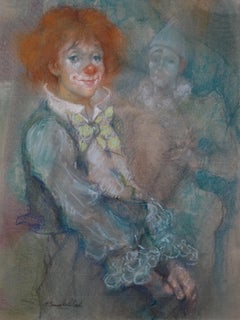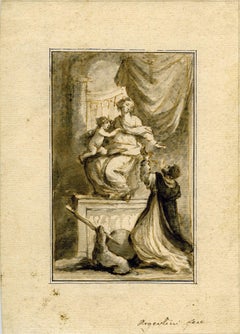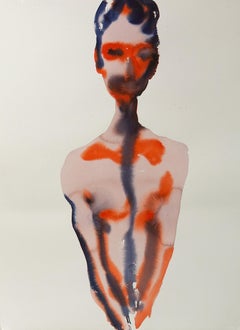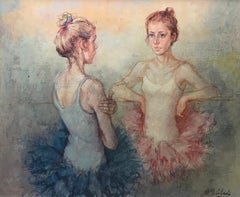Antonio Gonzalez Collado Figurative Paintings
Spanish, b. 1930
Antonio Gonzalez Collado was born in 1930 in Spain.
In his youth, he was a high-level gymnast. He went to Paris for a competition in 1955, fell in love with the city and captivated by the discovery of the Louvre, he promised himself to return to live there. First a student at Montparnasse 80 and at the Académie de la Grande Chaumière, he made his debut as a painter in Montmartre, place du Tertre, in 1957. In 1961, he won his first prize, the Prix de Deauville. In 1968, he was one of the painters exhibited at the Salon de Toile. The following year, it was found in the exhibition on the theme of the circus at the Musée de Montmartre. Then, he exhibited a lot in France, Belgium, Chicago and Canada.to
1
Overall Width
to
Overall Height
to
1
1
1
1
1
1
1
1
1
2
466
321
258
227
1
1
Artist: Antonio Gonzalez Collado
The Two Clowns (Les Deux Clowns) by Antonio Gonzalez Collado
By Antonio Gonzalez Collado
Located in Stockholm, SE
Artist: Antonio Gonzalez Collado
The Two Clowns (Les Deux Clowns)
mixed media on paper
signed
artist studio stamp on the back
dimensions (motif) 15...
Category
Late 20th Century Modern Antonio Gonzalez Collado Figurative Paintings
Materials
Paper, Mixed Media
Related Items
Neoclassical composition of a sculptor kneeling before his statue of the Madonna
Located in Middletown, NY
An allegory of loyalty, with the subject's dog pictured seated, holding his master's chisel in his mouth; fidelity personified.
Italian School, 18th century
Ink wash in gray and bl...
Category
Mid-18th Century Italian School Antonio Gonzalez Collado Figurative Paintings
Materials
Laid Paper, Ink, Watercolor
$500
H 9.73 in W 7.01 in
Self Portrait 02 - Modern Figurative Watercolor Painting, New Expressionism
By Maciej Olekszy
Located in Salzburg, AT
The artwork on paper will be sent unframed to you.
Maciej Olekszy was born in 1982, Poland. Graduated from the Academy of Fine Arts in Poznan, Poland in 2007. Faculty of Painting i...
Category
2010s Contemporary Antonio Gonzalez Collado Figurative Paintings
Materials
Paper, Watercolor
$1,417
H 41.34 in W 29.53 in
Early 20th Century Young Golfer Figurative
By Margaret Neilson
Located in Soquel, CA
Study of a young man with his golf clubs by listed artist Margaret Neilson Armstrong (American, 1867-1944). Image, 14"H x 20"W. Displayed in vintage mat. S...
Category
1920s Realist Antonio Gonzalez Collado Figurative Paintings
Materials
Paper, Pencil
"Path to Joy" Portrait in Ink, Gouache and Acrylic on Paper with Deckle Edge
By Kevin Snipes
Located in Philadelphia, PA
"Path to Joy" is an original piece by Kevin Snipes made from ink, gouache, and acrylic on paper. This piece measures 19.5”h x 9.25”w and is signed en verso.
Kevin Snipes (he/him) is...
Category
21st Century and Contemporary Contemporary Antonio Gonzalez Collado Figurative Paintings
Materials
Paper, Ink, Acrylic, Gouache
$1,800
H 19.5 in W 9.25 in
"Woman in a red dress in the garden full of roses"
Located in VÉNISSIEUX, FR
This woman in a red dress in the garden full of roses featured on the painting lost herself in the tender memories of a carefree childhood. She recalls the days when she was a littl...
Category
2010s Contemporary Antonio Gonzalez Collado Figurative Paintings
Materials
Paper, Oil
$372 Sale Price
30% Off
H 11.82 in W 11.82 in D 0.04 in
Follower Jacques-Louis David Neoclassical Red Chalck French Paper
Located in Roma, IT
Important period red chalck watercolor pencil drawing with neoclassical subject.
Depicting the Atilius Regulus departing for Carthage.
Atilius Regulus was a Roman statesman taken pri...
Category
Early 19th Century Old Masters Antonio Gonzalez Collado Figurative Paintings
Materials
Paper, Chalk
$945
H 27.56 in W 23.63 in D 1.19 in
Self Portrait - Contemporary Figurative Watercolor Painting, New Expressionism
By Maciej Olekszy
Located in Salzburg, AT
The artwork on paper will be sent unframed to you.
Maciej Olekszy was born in 1982, Poland. Graduated from the Academy of Fine Arts in Poznan, Poland in 2007. Faculty of Painting i...
Category
2010s Contemporary Antonio Gonzalez Collado Figurative Paintings
Materials
Watercolor, Paper
$1,122
H 29.93 in W 20.87 in
Clemente Pujol de Gustavino An orientalist Arab Guardsman
Located in New York, NY
Artist: Clemente Pujol de Guastavino (1850-1905)
Origin: Spanish
Signature: signed C. Pujol (lower right)
Medium: oil on canvas
Dimension: 25 1/2 in x 19 3/4 in. Framed 34 by 2...
Category
19th Century Antonio Gonzalez Collado Figurative Paintings
Materials
Canvas, Oil
$48,000
H 25.5 in W 19.75 in D 3 in
Young Man with a Sword, a Fist on his Hip, a drawing by Cornelis Saftleven
Located in PARIS, FR
Black chalk and white highlights on paper (originally washed in blue)
Monogrammed and dated 1630 on the right
This drawing, executed in black chalk and enhanced with white brushwor...
Category
1630s Old Masters Antonio Gonzalez Collado Figurative Paintings
Materials
Paper, Chalk
$18,905
H 17.38 in W 13.88 in
Rare Modernist Hungarian Rabbi Pastel Drawing Gouache Painting Judaica Art Deco
By Hugó Scheiber
Located in Surfside, FL
Rabbi in the synagogue at prayer wearing tallit and tefillin.
Hugó Scheiber (born 29 September 1873 in Budapest – died there 7 March 1950) was a Hungarian modernist painter.
Hugo Scheiber was brought from Budapest to Vienna at the age of eight where his father worked as a sign painter for the Prater Theater. At fifteen, he returned with his family to Budapest and began working during the day to help support them and attending painting classes at the School of Design in the evening, where Henrik Papp was one of his teachers. He completed his studies in 1900. His work was at first in a post-Impressionistic style but from 1910 onward showed his increasing interest in German Expressionism and Futurism. This made it of little interest to the conservative Hungarian art establishment.
However, in 1915 he met the great Italian avant-gardist Filippo Tommaso Marinetti and the two painters became close friends. Marinetti invited him to join the Futurist Movement. The uniquely modernist style that he developed was, however, closer to German Expressionism than to Futurism and eventually drifted toward an international art deco manner similar to Erté's. In 1919, he and his friend Béla Kádar held an exhibition at the Hevesy Salon in Vienna. It was a great success and at last caused the Budapest Art Museum to acquire some of Scheiber's drawings. Encouraged, Scheiber came back to live in Vienna in 1920.
A turning point in Scheiber's career came a year later, when Herwarth Walden, founder of Germany's leading avant-garde periodical, Der Sturm, and of the Sturm Gallery in Berlin, became interested in Scheiber's work. Scheiber moved to Berlin in 1922, and his paintings soon appeared regularly in Walden's magazine and elsewhere. Exhibitions of his work followed in London, Rome, La Paz, and New York.
Scheiber's move to Germany coincided with a significant exodus of Hungarian artists to Berlin, including Laszlo Moholy-Nagy and Sandor Bortnyik. There had been a major split in ideology among the Hungarian avant-garde. The Constructivist and leader of the Hungarian avantgarde, Lajos Kassák (painted by Hugó Scheiber in 1930) believed that art should relate to all the needs of contemporary humankind. Thus he refused to compromise the purity of his style to reflect the demands of either the ruling class or socialists and communists. The other camp believed that an artist should be a figurehead for social and political change.
The fall out and factions that resulted from this politicisation resulted in most of the Hungarian avant gardists leaving Vienna for Berlin. Hungarian émigrés made up one of the largest minority groups in the German capital and the influx of their painters had a significant effect on Hungarian and international art. Another turning point of Scheiber's career came in 1926, with the New York exhibition of the Société Anonyme, organized by Katherine Dreier. Scheiber and other important avant garde artists from more than twenty-three countries were represented. In 1933, Scheiber was invited by Marinetti to participate in the great meeting of the Futurists held in Rome in late April 1933, Mostra Nazionale d’Arte Futurista where he was received with great enthusiasm. Gradually, the Hungarian artists began to return home, particularly with the rise of Nazism in Germany. Kádar went back from Berlin in about 1932 and Scheiber followed in 1934.
He was then at the peak of his powers and had a special flair in depicting café and cabaret life in vivid colors, sturdily abstracted forms and spontaneous brush strokes. Scheiber depicted cosmopolitan modern life using stylized shapes and expressive colors. His preferred subjects were cabaret and street scenes, jazz musicians, flappers, and a series of self-portraits (usually with a cigar). his principal media being gouache and oil. He was a member of the prestigious New Society of Artists (KUT—Képzőművészek Új Társasága)and seems to have weathered Hungary's post–World War II transition to state-communism without difficulty. He continued to be well regarded, eventually even receiving the posthumous honor of having one of his images used for a Russian Soviet postage stamp (see image above). Hugó Scheiber died in Budapest in 1950.
Paintings by Hugó Scheiber form part of permanent museum collections in Budapest (Hungarian National Museum), Pecs (Jannus Pannonius Museum), Vienna, New York, Bern and elsewhere. His work has also been shown in many important exhibitions, including:
"The Nell Walden Collection," Kunsthaus Zürich (1945)
"Collection of the Société Anonyme," Yale University Art Gallery, New Haven, Connecticut (1950)
"Hugó Scheiber: A Commemorative Exhibition," Hungarian National Museum, Budapest (1964)
"Ungarische Avantgarde," Galleria del Levante, Munich (1971)
"Paris-Berlin 1900-1930," Centre Georges Pompidou, Paris (1978)
"L’Art en Hongrie, 1905-1920," Musée d’Art et l’Industrie, Saint-Etienne (1980)
"Ungarische Avantgarde in der Weimarer Republik," Marburg (1986)
"Modernizmus," Eresz & Maklary Gallery, Budapest (2006)
"Hugó Scheiber & Béla Kádár," Galerie le Minotaure, Paris and Tel Aviv (2007)
Hugó Scheiber's paintings continue to be regularly sold at Sotheby's, Christie's, Gillen's Arts (London), Papillon Gallery (Los Angeles) and other auction houses.
He was included in the exhibition The Art Of Modern Hungary 1931 and other exhibitions along with Vilmos Novak Aba, Count Julius Batthyany, Pal Bor, Bela Buky, Denes Csanky, Istvan Csok, Bela Czobel, Peter Di Gabor, Bela Ivanyi Grunwald, Baron Ferenc Hatvany, Lipot Herman, Odon Marffy, C. Pal Molnar...
Category
Early 20th Century Modern Antonio Gonzalez Collado Figurative Paintings
Materials
Paper, Charcoal, Pastel, Watercolor, Gouache
$5,500
H 15.75 in W 14.5 in
Sweet morning with a cup of coffee
Located in VÉNISSIEUX, FR
This contemporary colorful painting "Sweet morning with a cup of coffee" done in an impressionist style with a modern touch of brut expressionist art makes part of my "Women" serie...
Category
2010s Contemporary Antonio Gonzalez Collado Figurative Paintings
Materials
Paper, Acrylic
$397 Sale Price
30% Off
H 16.54 in W 11.7 in D 0.04 in
Charulata, Conte & Oil on Canvas, Grey Brown white Color , by Master Artist Wasim
By Wasim Kapoor
Located in Kolkata, West Bengal
Wasim Kapoor - Untitled - 30 x 34 inches ( unframed size )
Oil and Conte on Canvas. . The listed price if for the rolled work . Should you wish to receive it framed the shipping shou...
Category
Early 2000s Contemporary Antonio Gonzalez Collado Figurative Paintings
Materials
Canvas, Mixed Media, Conté, Oil
$4,800
H 40 in W 36 in D 1.5 in
Previously Available Items
Dancers leaning on the barre by Antonio Gonzalez Collado - Oil on canvas
By Antonio Gonzalez Collado
Located in Geneva, CH
Oil on canvas
Gilded wooden frame
73 x 84 x 4 cm
Canvas Back Artist Stamp
Signed to lower right
Category
Late 20th Century Modern Antonio Gonzalez Collado Figurative Paintings
Materials
Oil
H 21.26 in W 25.6 in D 0.79 in
Antonio Gonzalez Collado figurative paintings for sale on 1stDibs.
Find a wide variety of authentic Antonio Gonzalez Collado figurative paintings available for sale on 1stDibs. You can also browse by medium to find art by Antonio Gonzalez Collado in mixed media, oil paint, paint and more. Much of the original work by this artist or collective was created during the 20th century and is mostly associated with the modern style. Not every interior allows for large Antonio Gonzalez Collado figurative paintings, so small editions measuring 12 inches across are available. Customers who are interested in this artist might also find the work of Elisabeth Sabala, Alvar Sunol Munoz-Ramos, and Alfredo Roldan. Antonio Gonzalez Collado figurative paintings prices can differ depending upon medium, time period and other attributes. On 1stDibs, the price for these items starts at $723 and tops out at $1,925, while the average work can sell for $1,324.



